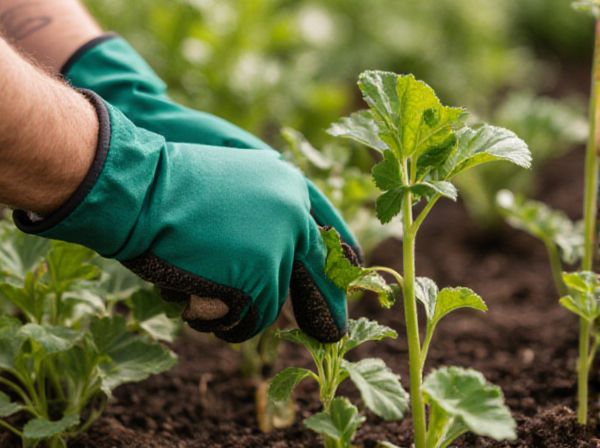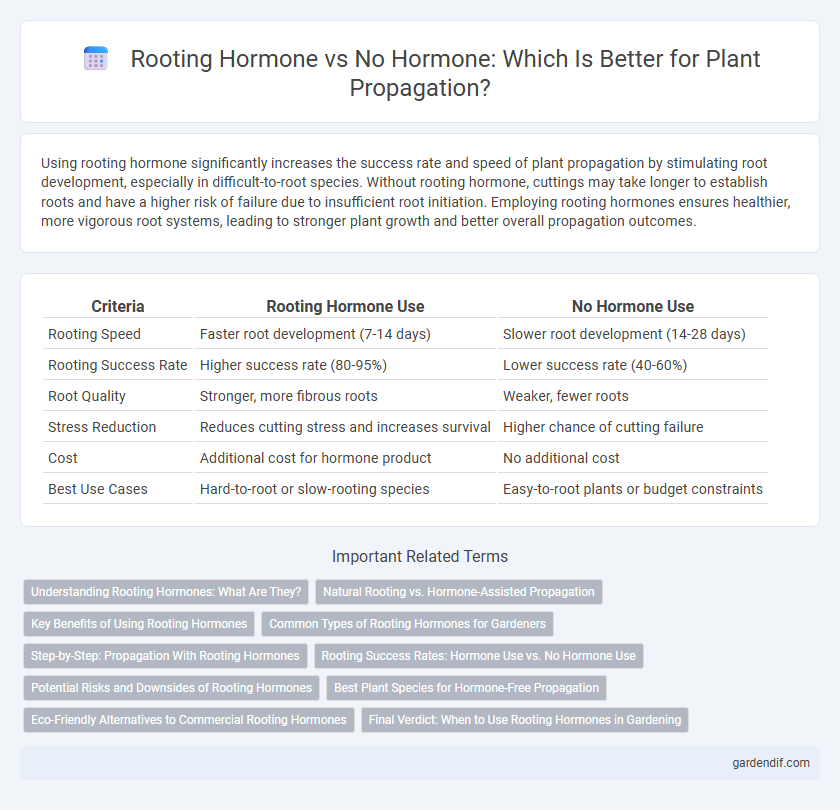
Rooting Hormone Use vs No Hormone Use Illustration
Using rooting hormone significantly increases the success rate and speed of plant propagation by stimulating root development, especially in difficult-to-root species. Without rooting hormone, cuttings may take longer to establish roots and have a higher risk of failure due to insufficient root initiation. Employing rooting hormones ensures healthier, more vigorous root systems, leading to stronger plant growth and better overall propagation outcomes.
Table of Comparison
| Criteria | Rooting Hormone Use | No Hormone Use |
|---|---|---|
| Rooting Speed | Faster root development (7-14 days) | Slower root development (14-28 days) |
| Rooting Success Rate | Higher success rate (80-95%) | Lower success rate (40-60%) |
| Root Quality | Stronger, more fibrous roots | Weaker, fewer roots |
| Stress Reduction | Reduces cutting stress and increases survival | Higher chance of cutting failure |
| Cost | Additional cost for hormone product | No additional cost |
| Best Use Cases | Hard-to-root or slow-rooting species | Easy-to-root plants or budget constraints |
Understanding Rooting Hormones: What Are They?
Rooting hormones contain synthetic or natural auxins that stimulate root development in plant cuttings, enhancing propagation success rates. These hormones accelerate cell division and elongation at the cutting site, promoting faster and stronger root formation compared to untreated cuttings. Using rooting hormones significantly improves the chances of survival and growth in various plant species, especially those that are difficult to propagate.
Natural Rooting vs. Hormone-Assisted Propagation
Natural rooting often relies on the plant's inherent auxins to develop roots, resulting in slower propagation with variable success rates depending on species. Hormone-assisted propagation uses synthetic rooting hormones like indole-3-butyric acid (IBA) to stimulate faster root initiation and improve the consistency of rooting across a wider range of plant cuttings. Studies show that hormone treatments can increase root formation success by up to 70% compared to no hormone use, making it a preferred method for commercial and home gardeners seeking efficient propagation.
Key Benefits of Using Rooting Hormones
Using rooting hormones significantly increases the success rate of plant propagation by accelerating root development and reducing the risk of cutting failure. Rooting hormones contain auxins, which stimulate cell division and elongation, leading to faster and stronger root formation compared to no hormone use. This results in healthier plants with improved nutrient absorption and overall growth performance.
Common Types of Rooting Hormones for Gardeners
Common types of rooting hormones for gardeners include auxin-based powders, gels, and liquid solutions, which stimulate root growth by mimicking natural plant hormones like indole-3-butyric acid (IBA) and naphthaleneacetic acid (NAA). Using rooting hormones typically results in faster root development and higher success rates compared to no hormone use, especially in difficult-to-root cuttings such as woody plants and certain perennials. Synthetic options are widely available, but organic alternatives derived from natural sources like willow or honey also provide effective rooting stimulation.
Step-by-Step: Propagation With Rooting Hormones
Applying rooting hormones significantly increases the success rate of plant propagation by stimulating root development at the cutting site. Start by selecting healthy cuttings, then dip the cut end into the rooting hormone powder or gel, ensuring even coverage before planting in a moist, sterile growing medium. Maintain consistent moisture and appropriate environmental conditions to encourage faster root formation compared to cuttings without hormone treatment.
Rooting Success Rates: Hormone Use vs. No Hormone Use
Rooting hormones significantly increase propagation success rates by accelerating root development and improving root quality in cuttings compared to no hormone use. Studies show rooting success with hormone application can exceed 80%, whereas no hormone use often results in success rates below 50%. The active ingredients in rooting hormones, such as auxins like indole-3-butyric acid (IBA), stimulate root initiation and enhance overall plant establishment.
Potential Risks and Downsides of Rooting Hormones
Rooting hormones, while effective at accelerating root development, carry potential risks including chemical burns, aphid attraction, and fungal infections that can harm young plant cuttings. Overuse or improper application may inhibit root growth or cause plant stress, reducing overall propagation success rates. Choosing hormone-free propagation methods can lower these risks but may require longer rooting times and more careful environmental control.
Best Plant Species for Hormone-Free Propagation
Many herbaceous plants like coleus, spider plant, and mint root efficiently without the use of rooting hormones, making them ideal for hormone-free propagation. Woody plants such as willow and hydrangea also tend to develop roots naturally, reducing the need for synthetic additives. Selecting species with high endogenous auxin levels ensures successful propagation without external rooting hormone application.
Eco-Friendly Alternatives to Commercial Rooting Hormones
Eco-friendly alternatives to commercial rooting hormones include natural substances such as willow water, honey, and aloe vera, which promote root development while minimizing environmental impact. Willow water contains natural rooting hormones like indolebutyric acid (IBA) and has antifungal properties that enhance propagation success without chemical additives. Using these organic options supports sustainable gardening practices, reduces reliance on synthetic chemicals, and fosters healthier plant growth.
Final Verdict: When to Use Rooting Hormones in Gardening
Using rooting hormones significantly enhances the success rate of plant cuttings by accelerating root development and improving overall plant health. Rooting hormones are especially beneficial for difficult-to-root species and hardwood cuttings, where natural rooting is slow or uncertain. Gardeners should opt for rooting hormones when propagation speed and reliability are priority factors for optimal plant growth.
Rooting Hormone Use vs No Hormone Use Infographic

 gardendif.com
gardendif.com